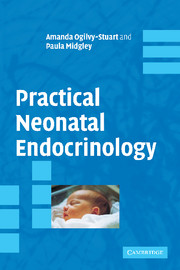Book contents
- Frontmatter
- Contents
- Acknowledgements
- Introduction
- 1 Hyperglycaemia
- 2 Hypoglycaemia
- 3 Management of hyperinsulinism
- 4 Hypoglycaemia in infant of a diabetic mother
- 5 Dysmorphic features
- 6 Micropenis
- 7 Hypopituitarism
- 8 Ambiguous genitalia (male): XY disorders of sex development
- 9 Cryptorchidism
- 10 Ambiguous genitalia (female): XX disorders of sex development
- 11 Pigmented scrotum
- 12 Adrenal failure
- 13 Collapse
- 14 Hypotension
- 15 Hyponatraemia
- 16 Hyperkalaemia
- 17 Hypernatraemia
- 18 Maternal steroid excess
- 19 Hypercalcaemia
- 20 Hypocalcaemia
- 21 Investigation and management of babies of mothers with thyroid disease
- 22 Maternal or familial thyroid disease
- 23 Goitre
- 24 Abnormal neonatal thyroid function tests
- 25 Hypothyroxinaemia in preterm infants
- Appendix 1 Calculation of glucose infusion rate
- Appendix 2 Dynamic tests
- Appendix 3 Normal ranges
- Appendix 4 Biochemistry samples
- Appendix 5 Formulary
- Index
11 - Pigmented scrotum
Published online by Cambridge University Press: 15 February 2010
- Frontmatter
- Contents
- Acknowledgements
- Introduction
- 1 Hyperglycaemia
- 2 Hypoglycaemia
- 3 Management of hyperinsulinism
- 4 Hypoglycaemia in infant of a diabetic mother
- 5 Dysmorphic features
- 6 Micropenis
- 7 Hypopituitarism
- 8 Ambiguous genitalia (male): XY disorders of sex development
- 9 Cryptorchidism
- 10 Ambiguous genitalia (female): XX disorders of sex development
- 11 Pigmented scrotum
- 12 Adrenal failure
- 13 Collapse
- 14 Hypotension
- 15 Hyponatraemia
- 16 Hyperkalaemia
- 17 Hypernatraemia
- 18 Maternal steroid excess
- 19 Hypercalcaemia
- 20 Hypocalcaemia
- 21 Investigation and management of babies of mothers with thyroid disease
- 22 Maternal or familial thyroid disease
- 23 Goitre
- 24 Abnormal neonatal thyroid function tests
- 25 Hypothyroxinaemia in preterm infants
- Appendix 1 Calculation of glucose infusion rate
- Appendix 2 Dynamic tests
- Appendix 3 Normal ranges
- Appendix 4 Biochemistry samples
- Appendix 5 Formulary
- Index
Summary
Clinical presentation
A pigmented scrotum is usually identified as an incidental finding on routine neonatal examination (Figure 11.1).
Approach to the problem
The usual reason for pigmentation of the scrotum is racial or familial. Note the family's racial origins, pigmentation being common in infants of Asian, African or Middle-Eastern origin. If none of these apply, are the family of dark colouring? (The Spanish Armada was responsible for adding to the British gene pool, particularly on the West Coast). Ask if scrotal pigmentation has been noted in a previous infant in the family.
Examination: Are the genitalia normal? Be sure the testes are palpable, i.e. the infant is male.
Differential diagnosis
Normal variation.
Congenital adrenal hyperplasia (CAH), (21-hydroxylase deficiency (21-OHD)).
Other causes of excessive adrenocorticotrophic hormone (ACTH) stimulation, e.g. ACTH resistance (familial glucocorticoid deficiency, FGD) and adrenal hypoplasia congenita (AHC).
Investigations
If the pigmentation is clearly of racial origin, no investigations are required, unless there are other risk factors for CAH, e.g. parental consanguinity.
Investigations are not required on day 1, unless the testes are not palpable or the genitalia appear abnormal (in both cases refer to Ambiguous genitalia, Chapter 8).
On day 3 weigh the infant and take a blood sample for:
Electrolytes and urea (salt loss in CAH may be expected from day 4).
The 17α-hydroxyprogesterone (17α-OHP) to screen for 21-OHD (this is sent to a specialized laboratory and the result may take several days).
ACTH (usually collected on ice).
- Type
- Chapter
- Information
- Practical Neonatal Endocrinology , pp. 79 - 82Publisher: Cambridge University PressPrint publication year: 2006



